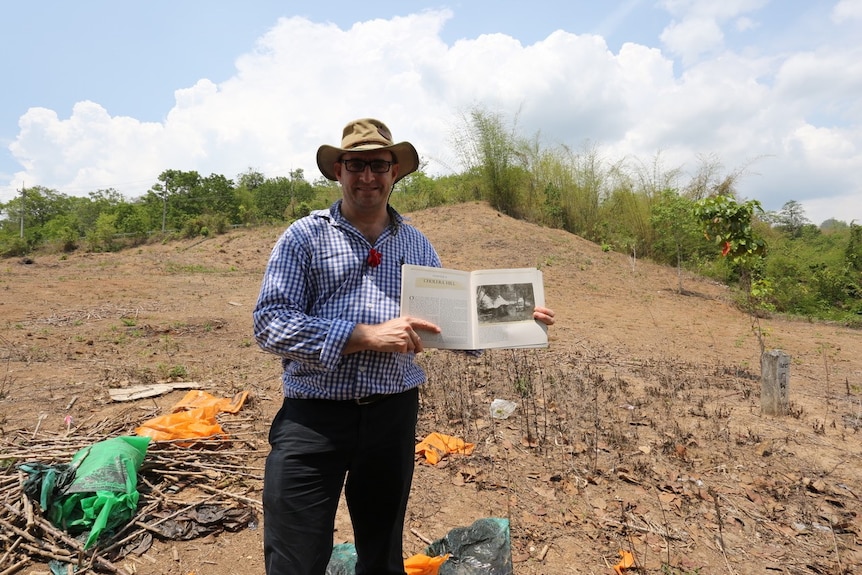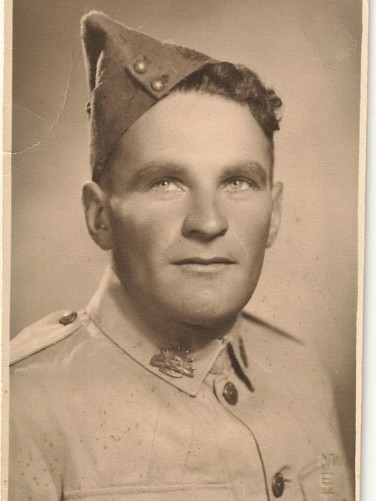This is our daily post that is shared across Twitter & Telegram and published first on here with Kindness & Love XX on peace-truth.com/
#AceNewsRoom in Kindness & Wisdom provides News & Views @acehistorynews

Ace Press News From Cutting Room Floor: Published: Jan.01: 2022:
#AceHistoryDesk - South Australian Rex Butler's time as a hard-riding buffalo shooter in the Northern Territory's crocodile swamps stood him in good stead when he went to war, fell into the hands of the Japanese and made an incredible escape.

Andrew Glynn at Cholera Hill on the Thai-Burma railway, a hospital for F-Force troops held at Shimo Sonkurai POW camp.(Supplied: Andrew Glynn)none
The Kongorong-born farmer was "deadly accurate" with a rifle and enlisted as a private in the AIF, 4th Military District, in 1940.
After Singapore capitulated to Japan's forces in February, 1942, Butler, an adventurer and experienced bushman, "could not be cooped up behind barbed wire", said Kevin Kenny, who was a prisoner of war (POW) with him in Changi.
Shipped to Borneo by the Japanese, Butler and a handful of other prisoners escaped, stole a canoe and paddled to the Tawi Tawi islands in the Philippines. He was killed in action the following year.

Rex Butler escaped from the Japanese in Borneo.(Supplied: Australian War Memorial)none
His story — along with those of 63 other POWs from South Australia's south-east — is remembered in a soon to be completed by another former Kongorong resident and now Asia-based businessman, Andrew Glynn.
"I guess I've always had an interest in military history," Mr Glynn said.
"Growing up in the small, rural town of Kongorong and communities of the south-east, I remember seeing the pictures of these POWs in the country halls.
"I learnt that there were at least half a dozen men from my little area who were captured by the Japanese and I decided to research what had happened to them in the war."The book will tell the stories behind memorials like this for Rex Butler in Port MacDonnell.(Supplied: Australian War Memorial )none
For the past nine years, Mr Glynn has uncovered personal letters, diaries and war affidavits, met descendants and travelled across the south-east of South Australia as well as historic battlefields and war camps in Asia to unearth the lost stories of local POWs.
"As I travelled around the south-east, I went to the war memorials and found that around a third of those men with their names on the statues had died as a result of being interned as prisoners of war," he said. Kongorong-born Andrew Glynn trekked to where the railway crossed from Thailand into Burma in 2015.(Supplied: Andrew Glynn)none
"I've now got a list of 63 people from the south-east who were captured by the Japanese.
"I've more or less got a sample of the whole Australian POW experience."
Mr Glynn said many of the men whose stories feature in his soon-to-be published book were on the infamous Thai-Burma railway.
"About a dozen on the Burma side and more again on the Thailand side of the railway, in camps like F-Force and D-Force, and about eight men who were with 'Weary' Dunlop at Hintok," he said.The remains of the notorious F-Force camp in Thailand.(Supplied: Andrew Glynn)none
Families find long-lost answers
Mr Glynn said much of his research involved speaking with families and descendants, many "hoping that I can help them with lost information, or stories they've been waiting a lifetime to hear".
"And I do come prepared, so I can help fill in missing parts of the story," he said.
"But it's very much a collaborative effort. I'm trying to get snippets and recollections of stories and knowledge that has been passed down over 75 years to the current generation."Allied soldiers are captured by the Japanese Imperial Army in Singapore in 1942.(Supplied: Australian War Memorial)none
Mr Glynn said he had heard some "fascinating" tales.
"There was a chap from Mount Gambier — Winston Bucknall — who was sent from Java up to Japan towards the end of the war and he was torpedoed on a boat in Nagasaki Harbour," he said.
"The Tamahoko Maru sank in two minutes, so if you were on the top of the ship you survived, if you were lucky.
"If you were down the bottom you had no chance. Out of the 770 men on the boat, 560 drowned, including this man.
"But when I was talking to some of his family, they told me about a two-minute meeting that Winston had with his cousin who was also on the boat … the cousin was going up on deck to sleep and survived, while Winston was going down below and drowned.
"Capturing those little snippets of oral family history and writing them down, I think that's really important."
Local experience unique
Mr Glynn said that, of about 21,500 Australians captured by the Japanese during World War II, about a third died in three-and-a-half years.
But for men from SA's south-east, "that ratio was a lot higher – around 56 per cent of our local men died".POWs were enslaved in terrible conditions in Japanese-run prison camps in Thailand.(Supplied: Australian War Memorial)none
"And you start thinking, why is that? Why was the death toll for the south-east so much higher than the national average?
"And it's all linked to what camps you were in, what unit you were in."
"We had a lot of men in support units and they ended up in Sandakan [Borneo] so they were part of the notorious Sandakan death marches. Some also went to Ambon.
"I think we probably suffered more than the average Australian community."
Mr Glynn said his book tells of the conditions endured by Australians in camps, including the prevalence of dysentery, cholera, malaria and scabies in primitive living quarters and the relentless tropical climate.POWs in a camp hospital on the Burma-Thailand railway in 1943.(Supplied: Australian War Memorial)none
And he said piecing together history had "its challenges".
"Because we had nearly 60 per cent of the men die, there's a lot of work to fill in the collective memory," he said.
"There are a lot of diaries, which have been very useful, conversations with families – and war crimes affidavits – but I'm also mindful of being as accurate as possible.
"The men didn't bring back much and a lot of them didn't speak much or didn't speak at all when they came home.
"But it's a way of giving these men – particularly those who didn't come home – a voice.
"A lot of them were single men, so it's a way of linking their stories with their descendants and our local history."
Retracing the steps of POW history
Living in Thailand and travelling throughout rural Asia, for the past 20 years, Mr Glynn says he has spent "a lot of time" visiting battlefields and historic camp sites.
"I've been through Java to see where the 2/3rd machine gun battalion men fought and were captured," he said.
"I'm trying to do most of the Thai-Burma railway by foot and get a feeling of what it must have been like in terms of the weather, vegetation and mud.
"A few years back I walked the [route of the] Sandakan death march."Mr Glynn has retraced the steps of Australian POWs on the Sandakan death marches in Borneo.(Supplied: Anderw Glynn)none
"But I'm a reasonably fit guy, not half starved. So of course the experience is vastly different but it does still give you a small insight because these country boys from South Australia, and nearby western Victoria, had never experienced the tropics before."
Mr Glynn says he hopes the book will be a useful addition to local history and Australia's military experience more broadly.
"It's how Australia collectively tells this story," he said.
"And it's telling the stories without airbrushing or embellishing because not all the stories are heroic.
"There's occasionally unsavoury stories of theft in camps, bad leadership from officers and that's part of our national collective too.
"On the other end of the spectrum, there're officers like Major Reg Newton on the railway who wrote cheques from his own personal funds to buy food for his men and he had a five per cent death rate."
Andrew Glynn is based in Thailand and is finalising work on the book. To contact him in relation to the work, email andrewglynn@agspec.net
Editor says …Sterling Publishing & Media Service Agency is not responsible for the content of external site or from any reports, posts or links, and can also be found here on Telegram: https://t.me/acenewsdaily and all wordpress and live posts and links here: https://acenewsroom.wordpress.com/ and thanks for following as always appreciate every like, reblog or retweet and free help and guidance tips on your PC software or need help & guidance from our experts AcePCHelp.WordPress.Com

 Peace & Truth
Peace & Truth





No comments:
Post a Comment